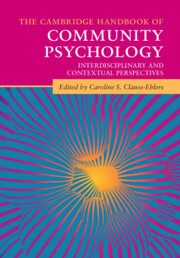Book contents
- The Cambridge Handbook of Community Psychology
- The Cambridge Handbook of Community Psychology
- Copyright page
- Dedication
- Contents
- Figures
- Tables
- Contributors
- Foreword
- Part I Foundational Concepts
- 1 Promoting Change amid Systemic Oppression
- 2 Community Psychology
- 3 Now Would Be a Great Time to Raise Your Voice
- 4 Ethics and Community Psychology
- 5 Defining Wellness across World Cultures
- Part II Research, Assessment, and Program Evaluation
- Part III Community Psychology in Action
- Part IV Where Do We Go from Here?
- Index
- References
4 - Ethics and Community Psychology
from Part I - Foundational Concepts
Published online by Cambridge University Press: 16 December 2021
- The Cambridge Handbook of Community Psychology
- The Cambridge Handbook of Community Psychology
- Copyright page
- Dedication
- Contents
- Figures
- Tables
- Contributors
- Foreword
- Part I Foundational Concepts
- 1 Promoting Change amid Systemic Oppression
- 2 Community Psychology
- 3 Now Would Be a Great Time to Raise Your Voice
- 4 Ethics and Community Psychology
- 5 Defining Wellness across World Cultures
- Part II Research, Assessment, and Program Evaluation
- Part III Community Psychology in Action
- Part IV Where Do We Go from Here?
- Index
- References
Summary
In this chapter we link community psychology values, particularly social justice, to intervention contexts, examining the essential role of ethics in the development and implementation of intervention strategies. We also review the status of ethical guidelines in community-based research. Three factors particularly critical to the development and implementation of successful interventions are whether the intervention is appropriate for the setting, whether the roles of the intervenor and participant are clearly articulated, and whether the intervention itself is sustainable. From these we identify three factors central in assessing any ethical concerns within the community psychology arena: taking the variable features of context into account; ensuring meaningful participant involvement; and addressing the sustainability of interventions.
- Type
- Chapter
- Information
- The Cambridge Handbook of Community PsychologyInterdisciplinary and Contextual Perspectives, pp. 70 - 85Publisher: Cambridge University PressPrint publication year: 2021



